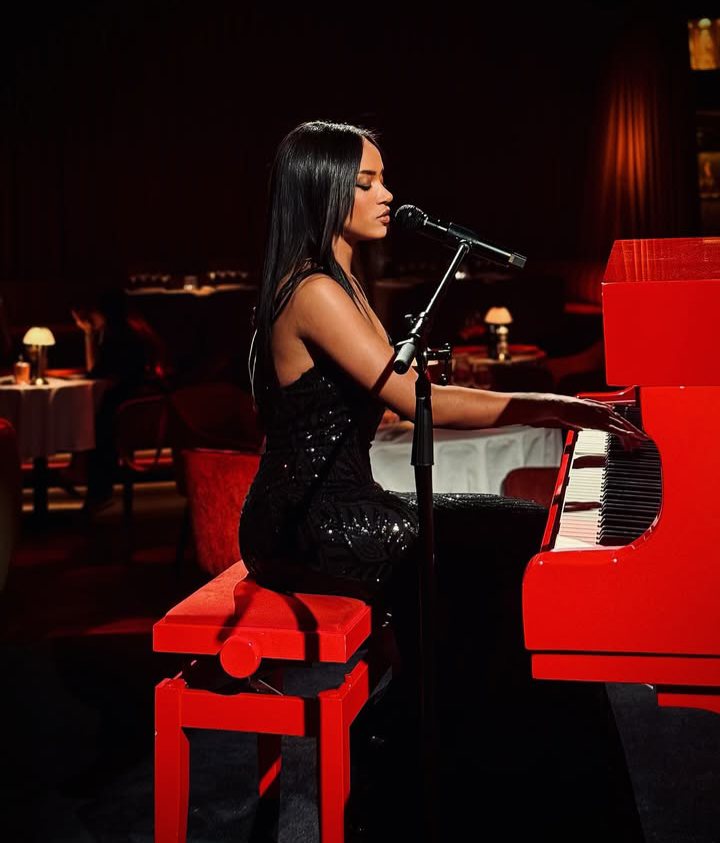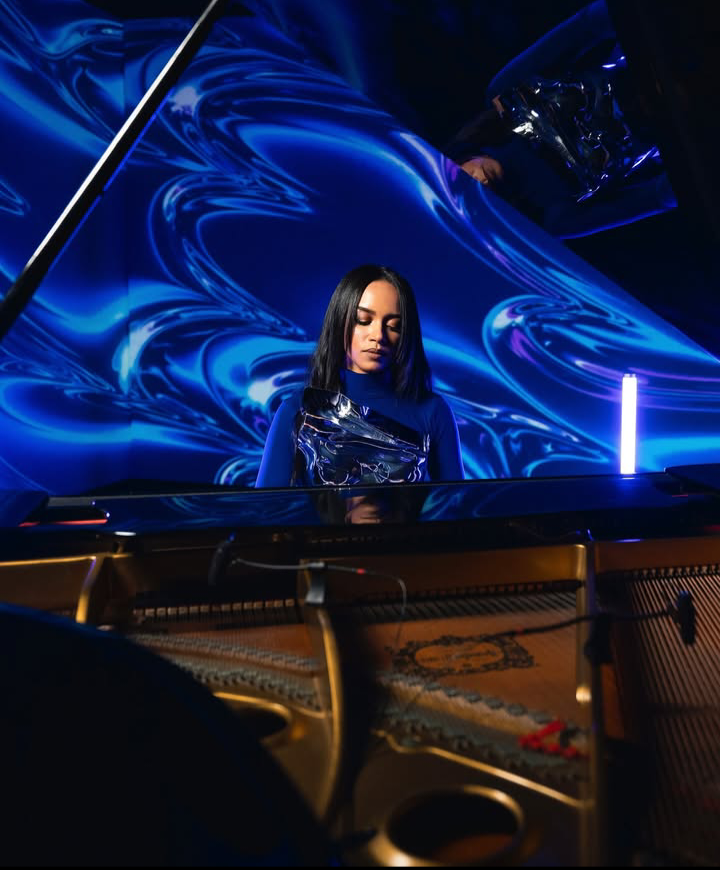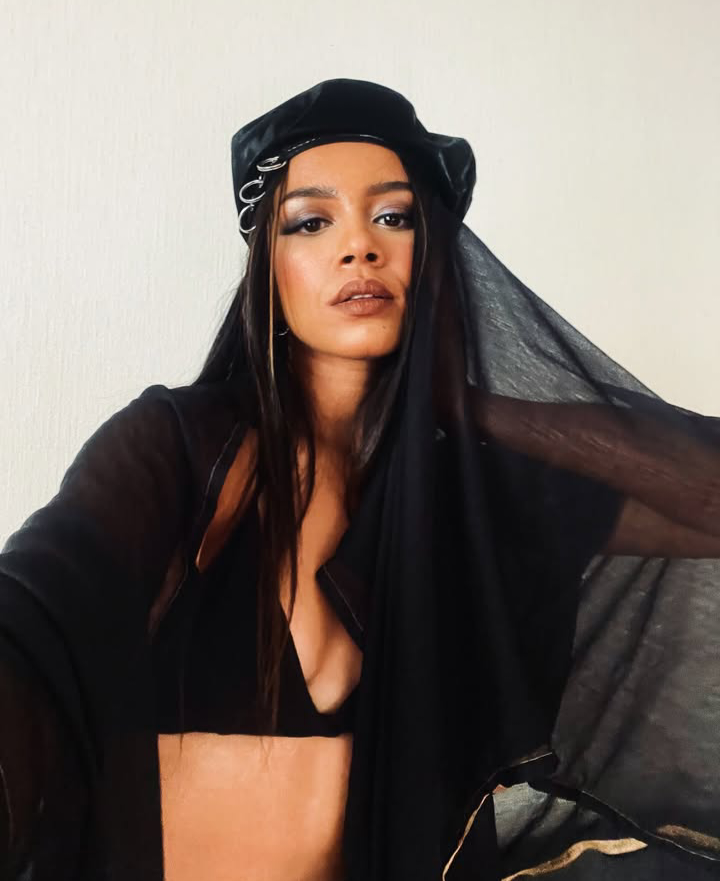Imelda Gabs is an unforgettable artist. From the very first notes of her album SYNOPSIS, she transports us into a dense, intimate, almost cinematic sonic universe. But behind this artistic mastery lies a free woman, driven by a clear vision and deep sensitivity. We meet a self-taught musician, producer, performer, and nomad who charts her own course with determination.
“Life is a journey,” she affirms from the outset. For Imelda, being a “wanderer” means accepting the prospect of losing oneself in order to better find oneself, drawing constant inspiration from the unknown. She has adopted this lifestyle both personally and artistically, nourishing her creativity through encounters, travels, and inner transformations.
Her project SYNOPSIS embodies this approach. In it, Imelda explores a new freedom, that of an artist asserting herself. Produced largely alone in her home studio, the album resonates as a manifesto of female independence in a still largely dominated industry. “That solitude was both liberating and powerful,” she says. The result: a sincere work, shaped according to her own vision, finalized with her band and polished at London’s legendary Metropolis Studios.

Being an independent artist comes with its share of challenges. She admits that sometimes the lack of direction can be unsettling, especially when juggling production, touring, and career management. But she also sees it as a wonderful life lesson. Each victory, each concert, each new release takes on a special meaning, as they are the result of total commitment.
For Imelda Gabs, visual work is never incidental. Passionate about cinema, she designs each visual as an extension of her music. With her partner and director Dariy Mambetov, she crafts immersive music videos, where each shot tells a story. The album cover, captured by photographer Ernest Em, testifies to this attention to the image, which she considers an essential component of her artistic universe.
Her creative method is fluid and intuitive. Sometimes words emerge, sometimes a melody speaks to her in the midst of an ordinary moment. The piano remains her refuge, a space where improvisation and emotion guide her composition. Trained in classical music, she maintains its rigor, but without confining herself to it. Emotion always takes precedence over structure.
On stage, Imelda transforms herself. “It’s where I feel most alive,” she says simply. The stage becomes a terrain of truth, a shifting space where each performance is unique, shaped by the moment, the audience, the atmosphere. She seeks human connection above all, rejecting perfection in favor of authenticity.
She has many roots: Belgian, Congolese, Swiss. For a long time, she was asked to choose, to define herself. She refused. Today, she fully embraces this hybridity, which is reflected in the diversity of her musical influences jazz, classical, rock, and electro. Rather than confine herself to a genre, she prefers to create a personal language, made of contrasts and intertwined heritages.
One of the most memorable moments of her artistic life remains this on-stage duet with her father, the legendary Congolese musician “Doctor Gabs” , at just 14 years old. “That memory follows me everywhere,” she confides. It was her first major concert, a seminal, unforgettable moment.
The cinematic aspect of her music is unashamed. She dreams of one day orchestrating a soundtrack for a film or a series, having already written string arrangements. Among her inspirations, she cites artists such as Aurora, Sevdaliza, Björk, FKA Twigs, and Caroline Polachek—figures who, like her, conceive of their art as a whole, where music, image, and narrative intertwine.
In pieces like “Thieves” and “Reckless,” she delivers a striking vulnerability. This choice is not insignificant: “That’s where the truth lies,” she says. By embracing her flaws, she frees herself and offers her audience a rare form of intimacy.
Recently, Imelda graced the stages of Dubai. The international stage is opening up to her, and her childhood dream to travel through music is gradually becoming a reality. The future? A world tour with her band, new songs, new horizons. And always, the same determination: to remain true to herself.
Imelda Gabs isn’t content to simply follow the rhythm of the music industry. She creates her own, unique, free, and profoundly human. An artist in her own right, who transforms her wounds into light, and her wanderings into strength.

License Interview Imelda Gabs: Discover exclusively Imelda’s journey
1. You describe yourself as a “wanderer”—a nomadic soul. What does this word mean to you, in your personal and artistic life?
To me, life is a journey, and I’ve learned that sometimes, you have to get a little lost in order to truly find yourself. That sense of exploration has deeply shaped both my personal life and my artistic path. Traveling, meeting new people, stepping out of my comfort zone, these experiences feed my creativity and push me to evolve. One lifetime may not be enough to see it all, but I plan to make the most of every moment I have.
2. Your album SYNOPSIS is an intense emotional journey. How did you construct its sonic and narrative universe?
As I grew into my career, I’ve learned to trust my instincts more and overthink less when it comes to composing and writing. I let the emotions guide me, the stories I want to tell shape the sound. SYNOPSIS is the beginning of a new chapter for me, not just musically, but in how I approach creativity as a whole. I produced most of it alone in my home studio, just me, my keyboard, and my computer. As a woman in music production, that solitude was both empowering and freeing. It allowed me to take full control of the sound, to shape the universe of the album exactly how I envisioned it. Later, I collaborated with my band on a few tracks, and wrapped it all up at Metropolis Studios in London.
3. You are an independent artist. What do you consider to be the greatest challenges and freedoms associated with this independence?
Being independent definitely comes with its share of challenges. Sometimes I don’t know who to turn to for advice or a second opinion, and juggling big projects, especially while touring, can feel like I need to be ten people at once. But at the same time, it’s been an incredibly rewarding journey. I’ve learned so much about the music industry by navigating it myself, lessons I might not have gained otherwise. And honestly, the wins feel even more meaningful because of the struggles behind them. Most of all, I value the creative freedom, being able to shape my sound and vision without compromise. Whether I stay independent or eventually sign with a label, it’s all been worth it.
4. How do you choose the powerful visuals that accompany your music? How important is imagery in your work?
As a cinema enthusiast, integrating visuals into my music has always felt essential. Imagery adds another layer to the sound—it invites the audience deeper into my world and helps tell the story beyond words and melody. I’ve been fortunate to collaborate with incredibly talented visual artists, especially my partner and film director Dariy Mambetov, who’s the visionary eye behind my music videos. I also had the honor of working with Ernest Em (@19tones), who photographed the cover of my album. Visual storytelling is a huge part of my creative identity, I can’t wait to dive back in.
5. Can you tell us about your creative process: do you write first on the piano, with lyrics, or with feelings?
It’s really a mix of all three! Sometimes words come to me first, and I’ll quickly write them down on paper if I’m lucky, or in my phone if I’m on the move. Other times, a melody will crash into my mind out of nowhere, and I’ll rush to record it before it fades. When I sit at the piano, I often improvise for hours, recording everything, because that’s when the most unexpected and honest ideas tend to appear.
My classical background definitely plays a role in the process. It gave me a foundation, a discipline. But I’ve learned to let go of structure when needed and just follow the emotion. I try not to force anything. I let the music lead the way.
6. You have a true mastery of the stage. What role does live performance play in your career, and how do you experience connecting with an audience?
The stage is where I feel most alive. It’s where the music becomes real, different every time, shaped by the people in the room, the space, the moment. Nothing’s ever exactly the same, and I love that. I never take it for granted that people choose to be there, to share that time with me. That alone means everything.
Performing has taught me to let go. Mistakes don’t scare me anymore, they often lead somewhere new, somewhere better. For me, music is about connection. And when I’m on stage, and I feel that connection, that’s when I know I’m doing what I’m meant to do.
7. You have Swiss and Congolese roots. How do these cultures influence your view of music and your artistic identity?
I grew up surrounded by a mix of cultures. Belgian on my mother’s side, Congolese from my father, and later Swiss, where I spent most of my life. Each of these roots has shaped who I am, both as a person and as an artist. Early on, I felt like I was being asked to choose, like I had to highlight one part of my identity to make myself more ‘understandable.’ But as I grew older, I realized I didn’t have to choose. I could embrace all of it.
That same realization carried over into my music. I was raised on a wide range of sounds; jazz, classical music, and rock were all part of my world growing up. And it was by listening to all those different styles that I eventually found my own. For a while, people would ask me to define my genre, to pick one. At some point, I just stopped trying to fit into one mold. My music is a reflection of all the parts of me, and I’ve learned to create freely, to let all the influences in and allow my identity to speak for itself.
8. What performance or moment in your career has had the greatest impact on you so far?
Without a doubt, the most impactful moment in my career was the first—and last—performance I shared with my father. One year before he passed, I had the chance to join him on stage at one of his concerts at BOZAR in Brussels. I was only 14, completely terrified, but that experience changed everything for me. It was my very first time on a big stage, and it shaped the way I’ve approached performance ever since.
Beyond that moment, my father’s journey has always been a huge source of inspiration to me. He came alone from Central Africa with a dream and made it a reality through music. I admire that deeply. Sharing that stage with him, even just once, is something I’ll carry with me for the rest of my life. I’m endlessly grateful to have had that moment by his side.
9. There’s a cinematic dimension to your music. Do you see yourself collaborating with the world of film or series?
Absolutely, it’s a big dream of mine. There’s something magical about how music shapes emotion in film. I sometimes write string arrangements when I have the time, and I’d love to one day expand that into full orchestral work. Getting the opportunity to collaborate on a film or series soundtrack would be such an honor.
10. Which artists or musical movements inspire you the most right now?
I’m really inspired by artists who blend genres, even more when acoustic and organic instruments meet electronic textures. There’s something about that contrast that brings the music to life in a whole new way. I think electronic music today offers so much creative freedom, and when it’s combined with more natural sounds, it can be incredibly powerful.
I also admire artists who have what I call a ‘360 vision’, where music is just one part of a bigger artistic universe. The visuals, the storytelling, the overall concept… it becomes a full experience. Artists like Aurora, Sevdaliza, especially her album ISON, which I think is absolutely out of this world, of course the magical Björk, FKA Twigs, Caroline Polachek, Oklou… they all inspire me deeply. And honestly, the list goes on!
11. The tracks “Thieves” and “Reckless” speak of strong emotions. What role does vulnerability play in your art?
It took me a long time to accept the darker parts of myself. Honestly, I’m still on that journey. But allowing myself to be vulnerable has made me stronger, both as a person and as a songwriter. The more I’ve embraced those raw, honest parts of me, the deeper my writing has become. Vulnerability isn’t always comfortable, but it’s where the truth lives, and that’s what I try to reach in my music.
12. You recently performed in Dubai. How are you experiencing the opening of your music to international stages?
I feel incredibly lucky to be able to travel thanks to music. As a child, performing around the world was one of my biggest dreams, and I’m so grateful to be living pieces of that dream today.
13. What are your plans or dreams for the future? Is there a venue, collaboration, or format that particularly appeals to you?
One of my biggest hopes is to go on a full international tour with my band. To travel the world and share those moments on stage together, that would be a dream come true. I’m also working on new music right now, and after nearly two years of silence, it feels like stepping into a brand new chapter. There’s so much I’m excited to explore, and I can’t wait to share what’s coming next.


That’s a really interesting take on risk assessment – it’s all about informed decisions! Seeing platforms like uu 88 gaining traction in Vietnam shows how entertainment & accessibility are key. A fun, safe “exploration” is a great approach! 👍